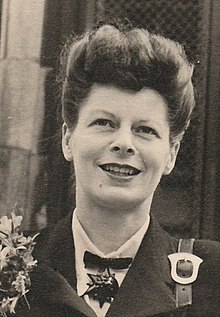
Gillian Greenwood, Baroness Greenwood of Rossendale (née Crawshay-Williams; 11 April 1910 – 19 July 1995), commonly known as Jill Greenwood, was an English artist, illustrator and designer, co-creator of the Ministry of Information's Make-Do and Mend pamphlet series and an important early member of the Campaign for Nuclear Disarmament.
Early life
Born Gillian Crawshay-Williams in London to parents Leslie Crawshay-Williams and Joyce Collier Kilburn, Greenwood was the younger of their two children (her elder brother being writer Rupert Crawshay-Williams, born in 1908).
Leslie Crawshay-Williams was the son of Welsh MP Arthur John Williams, while Joyce was the only child of artists John Collier and Marian Collier (née Huxley), making Jill's maternal great-grandfather English biologist and "Darwin's Bulldog" Thomas Henry Huxley.
Leslie and Joyce married in 1906 and divorced in 1918. Joyce Collier later remarried automobile retail agent Drysdale Kilburn; she was an accomplished artist in her own right and was a member of The Royal Society of Miniature Painters, Sculptors & Gravers.
After her parents' divorce, Greenwood was sent to a boarding school near Bishop's Stortford where she became head girl and a skilled tennis player.
Career

Greenwood attended art school in Chelsea and then joined the fashion brand Jaeger in 1931, where she known as "Crawshay". Initially employed in retail at their flagship Regent Street store, Greenwood's artistic flair was recognised and she was put in charge of display.
During the Second World War, Greenwood wrote and illustrated Make-Do and Mend pamphlets for the Ministry of Information. These iconic publications provided tips to housewives on harsh rationing, giving advice on how to stay frugal yet chic by reusing old clothing, creating ‘decorative patches’ to cover holes in worn garments; unpicking and re-knitting old jumpers, and protecting one's garments against the ‘moth menace’.
She remained at Jaeger for almost 30 years, playing a role in the design of their distinctive criss-crossed 'J' logo, and developing a reputation for her innovative and whimsical window dressings:
"Post-war at a time of shortage she famously designed an enormous pair of scales for the window of Jaeger's Regent Street shop balancing sheep, representing cashmere sweaters available only for export, against vital imports such as tea, coffee and New Zealand butter. Underneath in the shop window there was the laconic statement "Britain must balance her budget".
She devised the Regent Street decorations for the Festival of Britain in 1951, and in 1954 was the designer of Regent Street's first Christmas lights. In 1959 she arranged the decoration of Oxford Street's lampposts between Tottenham Court Road and Marble Arch for the first Christmas display. Eventually she was put in charge of Jaeger's window displays across the country, before retiring in 1960.
Personal life
Greenwood married German-born illustrator and cartoonist Walter Goetz in 1938. They divorced shortly afterward but they and their families remained good friends.
In 1940 she married British Labour Party politician Tony Greenwood (1911–1982), who entered Parliament as member for Heywood and Radcliffe in a by-election in February 1946, becoming a prominent Cabinet Minister in the 1950s and 1960s. They had two daughters, Susanna and Dinah Murray.

Greenwood died in 1995. She was cremated at Golders Green Crematorium.
Politics
A committed socialist and pacifist, Greenwood was an important early member of the Campaign for Nuclear Disarmanent (CND). As a male and prominent politician, her husband Tony was more visible, but Greenwood was the driving force behind their involvement.
Overcoming Tony's initial caution, they were both familiar figures at the head of Aldermaston marches in the early 1960s, while their daughter Susanna helped to found CND's youth wing.
References
- ^ "Person Page". www.thepeerage.com. Retrieved 7 October 2018.
- "NPG 6032; Marian Collier (née Huxley) - Portrait Extended - National Portrait Gallery". www.npg.org.uk. Retrieved 8 October 2018.
- Drysdale Kilburn, Graces Guide, Retrieved October 2018
- (Hons), Claire Russell BA. "Stella by Mrs Joyce Kilburn". www.royal-miniature-society.org.uk. Retrieved 8 October 2018.
- ^ Dalyell, Tam (11 August 1995). "Jill Greenwood.(Obituary)". The Independent (n2750): 16(1).
- "Make Do and Mend". www.bl.uk. Retrieved 7 October 2018.
- "Lady Greenwood of Rossendale (Category: Obituaries)". The Times (London, England). 27 July 1995.
- Dalyell, Tam (11 August 1995). "Obituary: Jill Greenwood". The Independent on Sunday. London.
- "Shedding light on Christmas". BBC News. 21 December 1997. Retrieved 22 September 2018.
- "Ban the Bomb Movement Walks From Aldermaston To London: 1952-1963 - Flashbak". Flashbak. 11 April 2014. Retrieved 7 October 2018.
- "Youth and Student CND". Youth and Student CND. Retrieved 7 October 2018.
External links
- Jill Greenwood's personal and professional papers are held within the "Arthur William James ('Anthony') Greenwood, Baron Greenwood of Rossendale (1911-82) Papers" at the Bodleian Library, University of Oxford:
- A photograph of Jill Greenwood is held by the National Portrait Gallery in London. It features the portrait of her Grandmother (Marian Collier Huxley) by her Grandfather (John Collier) in the background.